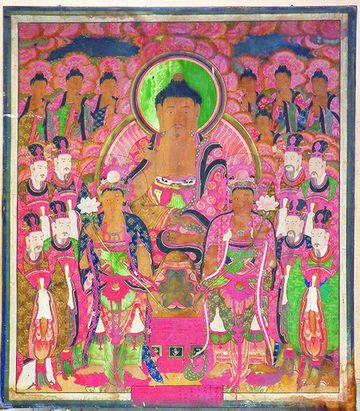"실상사 칠성도"의 두 판 사이의 차이
Mkichukova (토론 | 기여) (→영문) |
|||
| 33번째 줄: | 33번째 줄: | ||
===영문=== | ===영문=== | ||
'''Buddhist Painting of Silsangsa Temple (Seven Stars)''' | '''Buddhist Painting of Silsangsa Temple (Seven Stars)''' | ||
| + | |||
| + | This Buddhist painting is a painting depicting the Seven Stars, as in the seven stars of the Big Dipper, which are worshiped as a deity. For a long time, the Seven Stars has been worshipped in Korean folk religion as a spirit who controls the longevity and fortune of the humans. The Seven Stars having become a spirit spread to Buddhism is a phenomenon found only in Korea, which is an example of Korean Buddhism’s integration of local folk beliefs and practices. | ||
| + | |||
| + | Buddhist Painting of Silsangsa Temple was painted by painter monk Wanho (1869-1933), who lived mainly in Busan in the early 20th century, together with his disciple Wolju (1913-1992) in 1929. | ||
| + | |||
| + | In the center of the painting, Tejaprabha Buddha, depicted as the Buddha of Polaris, is sitting, with the seven Buddhas of the seven stars of the Big Dipper standing slightly behind him to his left and right. In front of Tejaprabha Buddha to his left and right are Suryaprabha (Bodhisattva of Sunlight) and Candraprabha (Bodhisattva of Moonlight), and eight deities are standing to the left and right of them, wearing robes. The yellow designs depicted on the clothes and the Sanskrit designs engraved on the pedestal are typical characteristics of Wanho's works. | ||
| + | |||
| + | The overall composition and layout of the characters (figures?), and the depiction of clouds by using red and yellow are examples of characteristics of (Seven Stars?) Buddhist paintings produced over the course of the 19th to the early 20th century. | ||
===영문 해설 내용=== | ===영문 해설 내용=== | ||
2020년 8월 10일 (월) 03:32 판
| 실상사 칠성도 Buddhist Painting of Silsangsa Temple (Seven Stars) |
|
| 대표명칭 | 실상사 칠성도 |
|---|---|
| 영문명칭 | Buddhist Painting of Silsangsa Temple (Seven Stars) |
| 한자 | 實相寺 七星圖 |
| 주소 | 부산광역시 동구 수정로68번길 7 실상사 |
| 지정번호 | 부산광역시 문화재자료 제84호 |
| 지정일 | 2015년 3월 18일 |
| 웹사이트 | 실상사 칠성도, 국가문화유산포털, 문화재청. |
|
|
|
해설문
국문
칠성도는 북두칠성을 신격화한 칠성(七星)을 그린 그림이다. 칠성은 인간의 수명과 길흉화복을 관장하는 신으로 민간에서 오랫동안 숭배의 대상이 되어 왔다. 칠성이 불교에 수용되어 신이 된 것은 우리나라에서만 볼 수 있는 현상이며 한국의 불교가 토착신앙과 조화를 이루며 발전했음을 보여준다.
그림 중앙에는 북극성(北極星)을 부처로 표현한 치성광여래(熾盛光如來)와 그 좌우에 북두칠성을 나타내는 7명의 부처를 배치하였다. 치성광여래의 앞쪽 좌우에는 일광보살과 월광보살을, 그 좌우에는 관복을 입은 8명의 천자(天子)를 두었다. 옷에 표현된 황색 무늬와 치성광여래 아래쪽의 네모난 대좌(臺座:불상을 올려놓는 대. 상현좌, 생령좌, 연화좌 따위가 있다.)에 적힌 범자(梵字) 무늬는 완호 스님의 작품에서 나타나는 전형적인 특징이다.
칠성도의 아래쪽에는 실상사 신중도와 마찬가지로 화가 완호(玩虎, 1869~1933) 스님과 제자인 월주(月洲, 1913~1992) 스님이 1929년에 함께 그림을 그렸다는 기록이 남아 있어 두 스님의 화풍을 짐작할 수 있다.
전체적인 구성과 인물 배치, 적색과 황색을 활용한 구름 표현 등은 19세기부터 20세기 전반에 걸쳐 제작된 칠성도의 특징을 잘 보여주고 있어 사료적 가치가 높은 문화재로 평가된다.
영문
Buddhist Painting of Silsangsa Temple (Seven Stars)
This Buddhist painting is a painting depicting the Seven Stars, as in the seven stars of the Big Dipper, which are worshiped as a deity. For a long time, the Seven Stars has been worshipped in Korean folk religion as a spirit who controls the longevity and fortune of the humans. The Seven Stars having become a spirit spread to Buddhism is a phenomenon found only in Korea, which is an example of Korean Buddhism’s integration of local folk beliefs and practices.
Buddhist Painting of Silsangsa Temple was painted by painter monk Wanho (1869-1933), who lived mainly in Busan in the early 20th century, together with his disciple Wolju (1913-1992) in 1929.
In the center of the painting, Tejaprabha Buddha, depicted as the Buddha of Polaris, is sitting, with the seven Buddhas of the seven stars of the Big Dipper standing slightly behind him to his left and right. In front of Tejaprabha Buddha to his left and right are Suryaprabha (Bodhisattva of Sunlight) and Candraprabha (Bodhisattva of Moonlight), and eight deities are standing to the left and right of them, wearing robes. The yellow designs depicted on the clothes and the Sanskrit designs engraved on the pedestal are typical characteristics of Wanho's works.
The overall composition and layout of the characters (figures?), and the depiction of clouds by using red and yellow are examples of characteristics of (Seven Stars?) Buddhist paintings produced over the course of the 19th to the early 20th century.
영문 해설 내용
칠성도는 북두칠성을 신격화한 칠성을 그린 그림이다. 칠성은 인간의 수명과 길흉화복을 관장하는 신으로 민간에서 오랫동안 숭배의 대상이 되어왔다. 칠성이 불교에 수용되어 신이 된 것은 한국에서만 볼 수 있는 현상이며, 한국의 불교가 토착신앙과 조화를 이루며 발전했음을 보여준다.
실상사의 칠성도는 20세기 초반 부산을 중심으로 활동한 승려화가 완호(1869-1933)와 그의 제자 월주(1913-1992)가 1929년에 함께 그렸다.
그림 중앙에는 북극성을 부처로 표현한 치성광여래가 앉아있고, 그 좌우에 북두칠성을 나타내는 7명의 부처를 배치하였다. 치성광여래의 앞쪽 좌우에는 일광보살과 월광보살이 있고, 그 양옆에는 관복을 입은 8명의 천자를 배치하였다. 옷에 표현된 황색 무늬와 대좌에 적힌 범자(梵字) 무늬는 완호의 작품에서 나타나는 전형적인 특징이다.
전체적인 구성과 인물 배치, 적색과 황색을 활용한 구름 표현 등은 19세기부터 20세기 전반에 걸쳐 제작된 칠성도의 특징을 잘 보여준다.
- 함안 능가사 칠성탱 참고
참고자료
- "실상사 칠성도", 부산광역시 지정문화재대장.
- "실상사 칠성도", 부산역사문화대전, 한국학중앙연구원. http://busan.grandculture.net/Contents?local=busan&dataType=99&contents_id=GC04219502
- "칠성", 한국민족문화대백과사전, 한국학중앙연구원. http://encykorea.aks.ac.kr/Contents/Item/E0058490
- "완호낙현", 불교신문, 2008.05.03. http://www.ibulgyo.com/news/articleView.html?idxno=87621
- "한국의 화승들 - (8) 월주 덕문 상", 법보신문, 2006.11.22. https://www.beopbo.com/news/articleView.html?idxno=44040
- "일본 연호 표기 거부한 최고 '금어(金魚: 불화를 최고의 경지에서 그리는 스님)'", 불교신문, 2015.07.22. http://www.ibulgyo.com/news/articleView.html?idxno=142302
- "실상사 불화 '신중도, 칠성도' 시문화재자료 지정]", 부산일보, 2015.05.11. http://www.busan.com/view/busan/view.php?code=20150509000004
